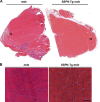Sarcospan reduces dystrophic pathology: stabilization of the utrophin-glycoprotein complex
- PMID: 18981229
- PMCID: PMC2575773
- DOI: 10.1083/jcb.200808027
Sarcospan reduces dystrophic pathology: stabilization of the utrophin-glycoprotein complex
Abstract
Mutations in the dystrophin gene cause Duchenne muscular dystrophy and result in the loss of dystrophin and the entire dystrophin-glycoprotein complex (DGC) from the sarcolemma. We show that sarcospan (SSPN), a unique tetraspanin-like component of the DGC, ameliorates muscular dystrophy in dystrophin-deficient mdx mice. SSPN stabilizes the sarcolemma by increasing levels of the utrophin-glycoprotein complex (UGC) at the extrasynaptic membrane to compensate for the loss of dystrophin. Utrophin is normally restricted to the neuromuscular junction, where it replaces dystrophin to form a functionally analogous complex. SSPN directly interacts with the UGC and functions to stabilize utrophin protein without increasing utrophin transcription. These findings reveal the importance of protein stability in the prevention of muscular dystrophy and may impact the future design of therapeutics for muscular dystrophies.
Figures




References
-
- Barresi, R., and K.P. Campbell. 2006. Dystroglycan: from biosynthesis to pathogenesis of human disease. J. Cell Sci. 119:199–207. - PubMed
-
- Campbell, K.P., and S.D. Kahl. 1989. Association of dystrophin and an integral membrane glycoprotein. Nature. 338:259–262. - PubMed
-
- Crosbie, R.H., J. Heighway, D.P. Venzke, J.C. Lee, and K.P. Campbell. 1997. Sarcospan: the 25-kDa transmembrane component of the dystrophin-glycoprotein complex. J. Biol. Chem. 272:31221–31224. - PubMed
-
- Crosbie, R.H., H. Yamada, D.P. Venzke, M.P. Lisanti, and K.P. Campbell. 1998. Caveolin-3 is not an integral component of the dystrophin-glycoprotein complex. FEBS Lett. 427:279–282. - PubMed
Publication types
MeSH terms
Substances
Grants and funding
LinkOut - more resources
Full Text Sources
Other Literature Sources
Molecular Biology Databases

